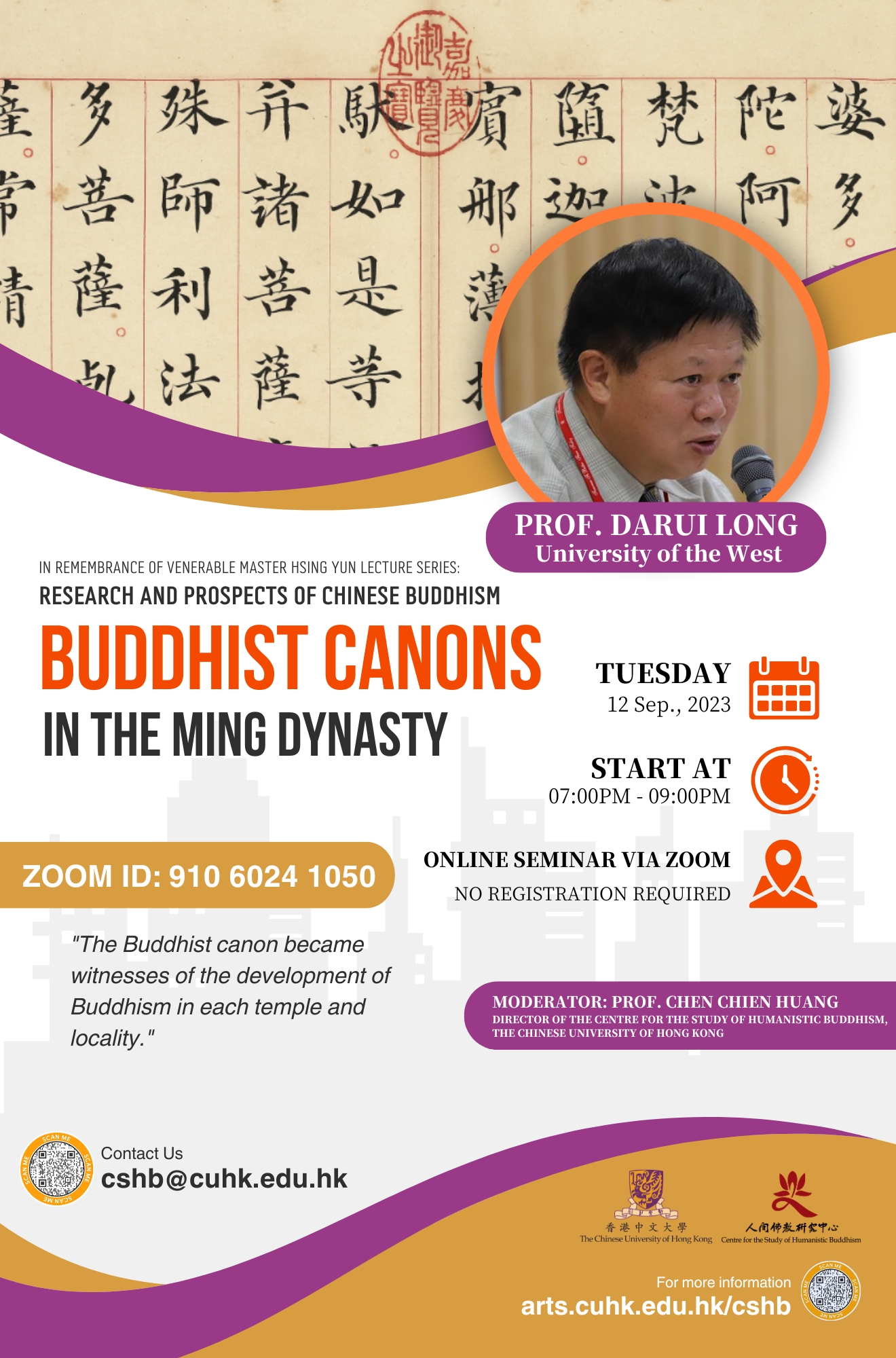Events
Buddhist Canons in the Ming Dynasty
12 Sep 2023
19:00~21:00
Webinar, ZOOM Meeting ID: 910 6024 1050
Prof. Darui Long, University of the West
Dr. Darui Long earned his Ph.D. from Graduate School, Chinese Academy of Social Sciences, Beijing, 1996. Upon his graduation, he obtained a “Senior Fellowship” from Center for the Study of World Religions, Harvard University in 1996. The next year, he received a scholarship from Harvard-Yenching Institute. He received Princeton University Library Scholarship twice in 2009 and 2020 and visited Princeton University three times to examine its collections of Chinese Buddhist canon. He visited Jagiellonian University Library in Poland in three summer from 2016-2018 to investigate into its collection of Chinese Buddhist literature.
Dr. Long’s research interest is Chinese Buddhist canon, especially the Yongle Northern Canon constructed in Beijing from 1419-1440. He was editor-in-chief of the book Chinese Buddhist Canon in the Age of Printing, published by Routledge, UK, 2020. He is currently editor-in-chief of Chinese Buddhist Canon Research Newsletter initiated by Center for Buddhist Studies, University of Arizona, USA.
Dr. Long traveled widely in China, the US and Poland, visiting libraries, museums and temples. He has taken more than 40,000 photos worldwide for his research work. In 2017, he found one volume of Lotus Sutra in the Tangut (Xixia) language written on indigo paper with gold powder, Jagiellonian University Library. It is an invaluable treasure in the world and has aroused scholars’ great interest.
Currently, he is working on a concordant catalogue of Yongle Northern Canon with other editions of Chinese Buddhist canon. He has published many academic papers on Chinese Buddhist canon.
Online Seminar via ZOOM, NO REGISTRATION REQUIRED
The Yongle beizang永樂北藏 (Yonle Northern Canon) was constructed following the decree by Emperor Yongle (r.1403 – 1424). The first main part was not completed until 1440. During the reign of Emperor Wanli 萬曆( r. 1573-1620), 41 han ( 函cases) with 410 volumes were added in 1584, totaling 6771 volumes. Many copies of this canon were either destroyed in natural disasters or wars in the past 500 years. Only 30 sets are extant. Most of them are incomplete.
In 2009 I began to investigate this Yongle Northern Canon kept in the East Asian Library, Princeton University. I found many new materials. I decided to investigate the extant copies. Since then, I have visited more than 25 libraries, museums and temples in China, the United States and Poland. I found that each set of this Buddhist canon has its unique characteristics, such as Emperor’s decree, colophons, inscriptions, seal stamps, donors, readers and even the silk covers and papers.
The Buddhist canon became witnesses of the development of Buddhism in each temple and locality. Local devotees donated money to build the library, to repair the damaged scriptures, to raise fund for various activities with the canon. The records of these activities are probably noted in the colophons, inscriptions of the steles in the temples, local gazetteers, the travel notes, essays of local scholar-officials, and temple history. These were neglected in the past.
《永樂北藏》是明成祖(1402-1424年在位)於1419年在北京刊刻的一部大藏經,初刻竣工於1440年。明神宗(1573-1620在位)時增加了41函,總計為 6771卷。經過500多年的滄桑,多數印本毀於災害或戰亂。存世的《永樂北藏》僅有約30餘套,多有殘缺。我自2009年起開始對普林斯頓大學東亞圖書館保存的一套不全的《永樂北藏》進行研究,發現了一些新材料,十餘年來,走訪了中國、美國、波蘭珍藏有《永樂北藏》的圖書館二十多處。通過親自翻檢大藏經,認識到每部大藏經都有其特點。如皇帝的敕令、題記、印章、捐資人、閲讀大藏經的讀者、護板的綢緞等過去研究中忽略的問題。
【Language】English


